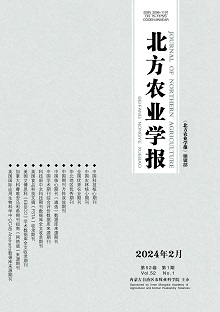【Objective】The effects of agronomic traits and forage quality of different oat varieties on their regeneration yield were clarified,which provided reference for the follow-up research and production practice of oat regeneration.【Methods】Taking 41 oat varieties as research materials,cutting at the heading stage of oats,the agronomic traits(plant height,flag leaf area,forage dry matter quality),forage quality traits(crude protein,crude fat,soluble sugar),regeneration capacity,and regeneration yield of oats were statistically analyzed,and the fuzzy mathematics membership function method was utilized to thoroughly evaluate the reproduction ability of oats.【Results】The coefficient of variation of plant height,flag leaf area and forage dry matter quality of oats cut at heading stage was 15.68%-22.83%.The coefficient of variation of crude protein content,crude fat content and soluble sugar content was 8.11% to 23.46%. The coefficient of variation of regeneration capacity and regeneration yield were 31.75% and 24.12%,respectively. The results of the correlation study revealed a positive correlation between the area of the flag leaf and the regeneration yield(P<0.05),a extreme positive correlation between the crude protein,crude fat,and soluble sugar contents and the regeneration yield(P<0.01)as well as a extreme positive correlation between regeneration capacity and regeneration yield(P<0.01). The top 10 species of oat,as determined by the thorough examination of 8 oat character indexes using fuzzy mathematics membership function method,were Monida,Baiyan No. 7,Aota,Mengte,Mengyan No. 1,Kuibeike,Beile,Qingyin No. 3,Tianyan No. 2 and Neiyan No. 5. Among them,Monida and Baiyan No. 7 had the best comprehensive characters,with strong regeneration capacity,good quality traits,and high regeneration yield. The full evaluation average value was 0.89、0.87.【Conclusion】When the oats were cut at heading stage,the crude protein content,crude fat content and soluble sugar content were positively correlated with the regeneration yield. The oat varieties with better regeneration capacity were Monida,Baiyan No. 7,Aota,Mengte,Mengyan No. 1,Kuibeike,Beile,Qingyin No. 3,Tianyan No. 2 and Neiyan No. 5.



